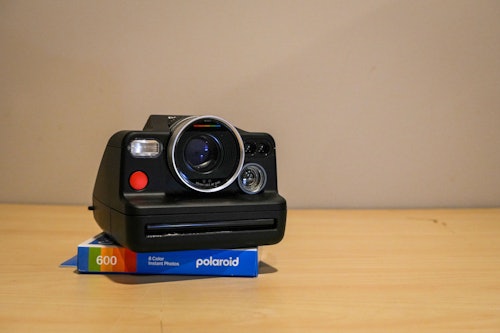Stick to a Fujifilm Instax unless you’re really into dialing in manual settings. have developed a reputation for being lighthearted, affordable, and easy to use. , is none of that.
In fact, the all-black (the only color it comes in) I-2 has a $600 price, includes built-in manual controls, and uses Polaroid’s sharpest lens yet. Polaroid’s I-2 feels like the antithesis of most out there today. Most of them lean heavily towards being a fun way to snap a retro shot with a toy-like design.
Polaroid went the complete opposite direction with the I-2, designing it more as a serious camera that takes a while to learn. I’m not saying you can’t use the I-2 in a pinch to capture a fleeting moment in auto mode, but it feels like driving a Ferrari just to pick up lunch. Polaroid did a stellar job at making the I-2 a top-of-the-line instant camera, but that doesn’t mean it’s the right choice for everyone.
Polaroid’s ambitious I-2 instant camera has built-in manual controls and takes most of its film packs. REKINDLING THE SPARK As someone who mainly shoots digital, using the I-2 was incredibly refreshing. It put me back into a mindset of embracing the behind photography.
It was hard to stop myself from counting up all the film I was using, but going through the paces of setting up the shot, messing up, readjusting the settings, only to rinse and repeat, was always fun. My favorite shots with the I-2 were the ones where I was more thoughtful about the composition and put more work into adjusting the settings and experimenting with different angles. However, for every crisp, sharp photo, there were many more that were severely underexposed, blown out, or blurry messes as a result of using the wrong settings.
I’ll admit that’s mostly my fault since Polaroid does try to make it easier. The I-2 has six shooting modes, including auto mode, aperture mode, shutter mode, multiple exposure mode, timer mode, and, of course, manual mode. Still, shooting in auto felt like no guarantee of a decent snap.
MORE DUDS THAN KEEPERS The I-2’s three-lens autofocusing system does a great job at finding the focus thanks to its integrated Lidar ranging meter. But I’d still mess up the shot sometimes by setting the shutter speed too slow and getting a ton of blur. It didn’t feel great to burn about $2.
50 for each failed photo but the ones that came out decent felt like striking gold with their soft washed-out colors, impressive depth, and details that actually looked sharp. My keepers are embarrassingly low compared to the number of duds I shot. Not wanting to eat through film packs ( , , and ), I was forced to be more present with the I-2 because I could immediately see if my results were great or garbage in physical form.
Even having played around with the I-2 for a couple of weeks, the amount of duds compared to the keepers I had was very telling. While I loved trying to learn a new camera with a different medium, the process is challenging and may not be for everyone. SERIOUS LEARNING CURVE Polaroid is clearly aiming at a specific demographic with the I-2.
It feels like the iconic camera brand is trying to coax serious photographers into experimenting and having fun with its professional-grade instant camera, rather than putting out a straightforward plasticky cam that everyone can use. It’s not exactly the approachable Fujifilm with fully automatic settings, nor is it like like Polaroid’s much simpler camera that can also do manual controls through a companion app. Polaroid put in an OLED display to show your settings.
The I-2 may look like an approachable instant camera, but it’s not as easy to use as it appears. I let some of my friends take a couple of shots where they stuck to Auto mode and the shots came out improperly exposed and not in focus. There’s nothing stopping you from firing off shots in auto with the I-2, but this does not feel like the ideal use case.
WORTH THE STRUGGLE One of the downsides I noticed with the I-2 was the viewfinder. I wasn’t expecting an ultra-bright electronic viewfinder like with modern mirrorless cameras, but it felt like staring through a finicky spyglass. On a more serious note, the real downside is the price.
At $600, you can buy three different instant cameras from Polaroid’s main competitor, Fujifilm, and still have some leftover cash to stock up on film packs. Taking an informal poll with my friends, many of them severely underestimated the price of the I-2, even after holding and playing around with the camera. It’s all worth it for those shots where everything works out.
Otherwise, the I-2 feels like an investment in both your money and your time. You have to be willing to take a lot of duds and learn from your mistakes to get that shot that makes it all feel worth it. On top of that, burning through film packs does quickly rack up the costs.
For me, I still don’t feel like I have a solid grasp of the I-2 and that’s after going through a few eight-packs of Polaroid’s Color 600 Film. With all that in mind, the I-2 isn’t the instant camera for everyone and I think Polaroid knows that. .
From: inverse
URL: https://www.inverse.com/tech/polaroid-i2-review-instant-camera-for-professionals



